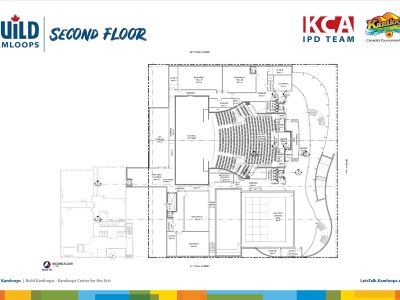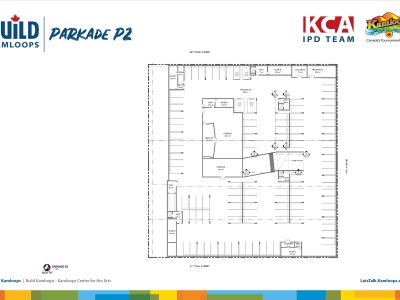Kamloops Centre for the Arts
The Kamloops Centre for the Arts (KCA) has been identified by the Build Kamloops Select Committee as the first priority for the visionary Build Kamloops program and will be an iconic structure that serves as a catalyst to grow, inspire, and unify our community.
After 18 months of detailed planning and validation, the project team—comprising of architects, engineers, builders, and City staff—has delivered a construction plan that is both ambitious and achievable.
The Kamloops Centre for the Arts will fill an important gap in the community that has been identified in strategic plans for almost two decades. This purpose-built facility will address the current and growing needs of Kamloops, hosting events ranging from graduations to awards ceremonies, to performing arts events. The Kamloops Centre for the Arts will serve as a cornerstone for economic growth, generating significant spinoff benefits through the Tournament Capital hosting program and attracting cultural tourism that supports local businesses, hospitality, and job creation. The Centre for the Arts will elevate the overall cultural vibrancy of our city.
The Kamloops Centre for the Arts project is funded through a balanced and flexible financial strategy designed to avoid additional borrowing or tax increases. Funding comes from a mix of debt, reserves, fundraising, and reallocation of existing funds, with adjustments made as risks are retired or new opportunities arise. The City is also actively pursuing grants, including up to $7 million from the Strategic Priorities Fund, and will continue seeking further grants and investment throughout the project. For full details and budget-related questions, please refer to the FAQs below.
-
Construction FAQs
Facility and Design FAQs
Built for Everyone
The KCA has been prioritized as the first Build Kamloops project chosen for its advanced design and City-owned land at 393 Seymour Street, next to Kelson Hall—home to Western Canada Theatre and Kamloops Symphony.
This will be Kamloops’ first new theatre since the Sagebrush Theatre opened in 1978. With over 40,000 more residents since the construction of the much-loved, but severely over-subscribed, Sagebrush Theater, the KCA will meet the growing demand for performing arts and community events.
The versatile venue will be inclusive and accessible, with features like elevators to all levels, accessible seating in both theatres, enclosed viewing spaces for sensory needs, and barrier-free access throughout. It will host everything from concerts to dance recitals, graduations, and live theatre—making it a true community space.
The KCA will lend itself to supporting the Tournament Capital program offering appropriately-sized space for sporting ceremonies and cultural celebrations.
Floor Plans
FAQs
Frequently Asked Questions About the Project
Facility Design and Amenities
Construction
Financials and Funding
Updates
Myth Busting
-
MYTH #1
The Kamloops Centre for the Arts is already $45 million over budget and costs are only going to rise.
MYTH #2
The City didn’t know the slope of the Seymour Street before choosing this location for the Kamloops Centre for the Arts, and this slope has had a significant impact on the design and budget of the facility.
Who's Listening
 Build Kamloops Council Select Committee
Build Kamloops Council Select Committee
City of KamloopsChaired by Councillor Hall, and includes Councillors Bepple, Middleton, O'Reilly, and Sarai.
 Byron McCorkell
Byron McCorkell
Chief Administrative Officer Carmin Mazzotta
Carmin Mazzotta
Director of Community and Culture Jen Fretz
Jen Fretz
Director of Civic Operations David Hallinan
David Hallinan
Director of Corporate Services Kristen Rodrigue
Kristen Rodrigue
Communications ManagerChair of the Joint Working Group
 Marvin Kwiatkowski
Marvin Kwiatkowski
Director of Development and Engineering
Contact Us
Have questions or want to learn more about a project, contact us below:
| Website | www.kamloops.ca |
|---|---|
| In writing | City of Kamloops, 7 Victoria Street West, Kamloops BC, V2C 1A2 |
Land Acknowledgement
The City of Kamloops acknowledges that we are located on Tk̓emlúps te Secwépemc territory, situated within the unceded ancestral lands of the Secwépemc Nation.
We honour and respect the people, the territory, and the land that houses our community.






















